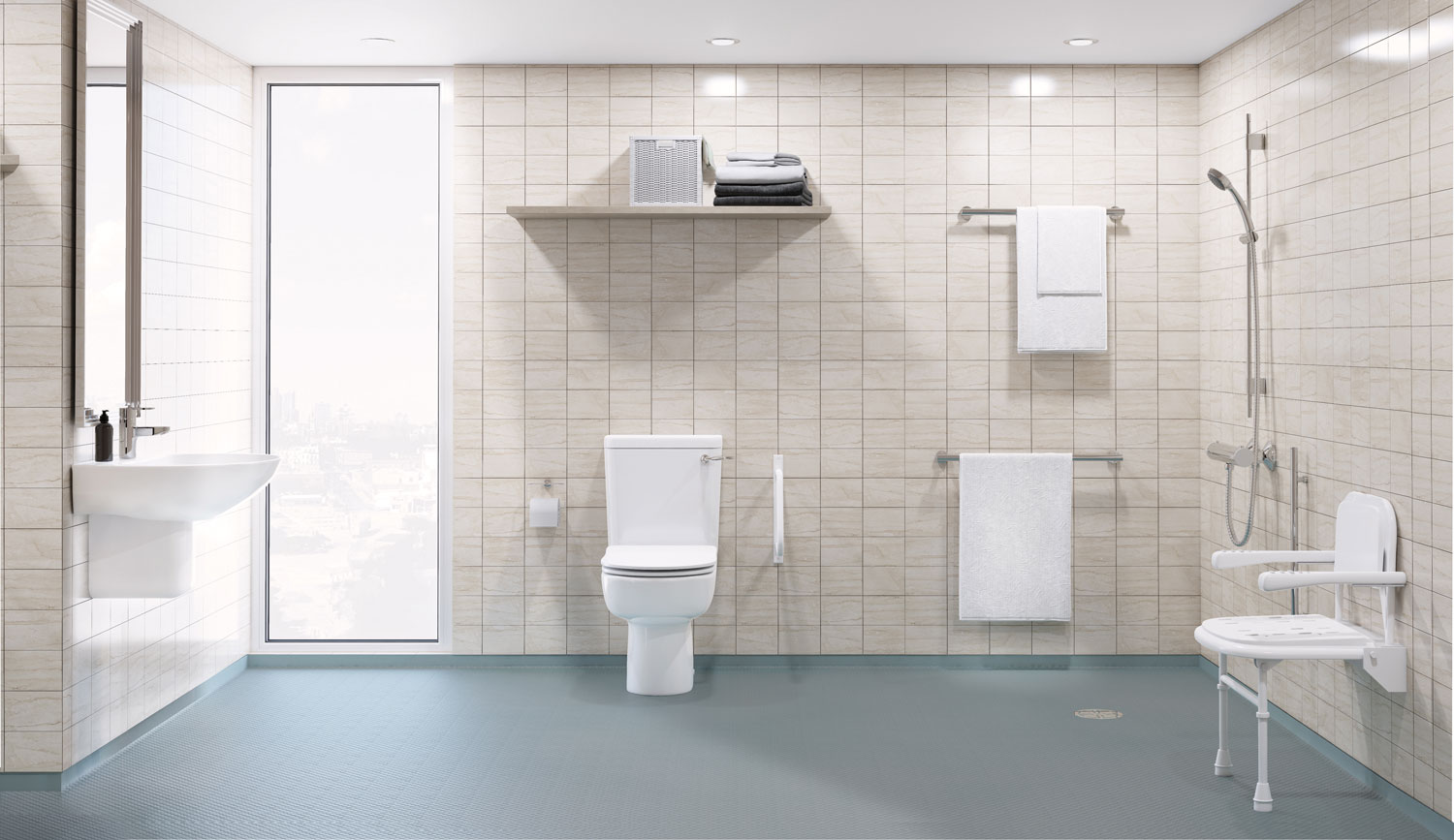Wet rooms are becoming increasingly popular, particularly in accessible bathroom design, offering both style and functionality. One of the key decisions in designing a wet room is choosing the right flooring.
With various options on the market, it’s crucial to understand their advantages and drawbacks. This article will delve into three commonly used wet room flooring types, helping you make an informed decision for your bathroom project. Get ready to explore the world of wet room flooring!
Introduction to Wet Room Flooring
Wet room flooring needs to be carefully selected as it plays a crucial role in ensuring safety, durability, and visual appeal. The flooring should not only be slip-resistant but also easy to clean and maintain. Additionally, it needs to be capable of withstanding the constant exposure to water and humidity that comes with the territory of a wet room.
Let’s delve into three of the most popular flooring options for wet rooms: vinyl, tiles, and resin and uncover the unique set of advantages and drawbacks of each.

Type 1: Vinyl Wet Room Flooring
Vinyl flooring has been a favourable choice for wet room flooring due to its practicality and versatility. Let’s take a closer look at the reasons behind its popularity and consider some of its potential drawbacks.
Advantages of Vinyl Flooring:
- Slip-resistance: Vinyl flooring provides excellent slip-resistance, a key safety feature for wet room flooring.
- Ease of cleaning: Vinyl floors are relatively easy to clean and require little maintenance, making them an ideal choice for a wet room.
- Variety of designs: Vinyl flooring offers a wide range of designs and colours, allowing you to customise your wet room to your exact aesthetic preferences.
- Cost-effective: Vinyl flooring tends to be less expensive compared to other types of flooring, making it a budget-friendly option.
Drawbacks of Vinyl Flooring:
- Durability: Although vinyl flooring is relatively durable, it can be susceptible to tears and rips over time.
- Temperature: Vinyl flooring can feel cold underfoot, which some people may find uncomfortable.
- Environmental impact: Vinyl flooring is not biodegradable and its production process can release harmful chemicals, making it less environmentally friendly than some other flooring options.
Type 2: Tiled Wet Room Flooring
Tiled flooring is another commonly used option in wet rooms, offering a classic look and a high degree of customisability. However, there are a few things that you should be aware of when choosing this type of flooring.
Advantages of Tiled Flooring:
- Durability: Tiles are highly durable and can withstand heavy foot traffic, making them a good long-term choice for your wet room.
- Design and customisation: With tiles, you have an extensive range of colours, sizes, shapes, and styles to choose from, allowing you to create a unique and appealing design.
- Water resistance: Tiles, particularly porcelain and ceramic types, are naturally water-resistant, making them suitable for wet room conditions.
Drawbacks of Tiled Flooring:
- Installation: The installation of tiles can be a complex process that typically requires professional installation.
- Cold underfoot: Like vinyl, tiles can also feel cold underfoot, which might not be pleasant for everyone.
- Grout maintenance: The grout between the tiles requires regular cleaning and maintenance to prevent mould and mildew build-up.
Choosing the right wet room flooring can significantly enhance the safety, convenience, and aesthetics of your bathroom. Considering the advantages and drawbacks of these flooring options can help you make the best choice for your specific needs and preferences. Stay tuned as we explore resin flooring next.
Type 3: Resin Wet Room Flooring
Resin flooring is the third type of wet room flooring we’re discussing. The seamless, contemporary finish of resin flooring has been gaining traction in modern bathroom design. However, it’s not all about aesthetics; resin flooring also has some practical advantages and a few drawbacks to be aware of.
Advantages of Resin Flooring:
- Durability: Resin floors are highly durable and resistant to wear and tear, making them an excellent long-term investment.
- Hygienic and easy to clean: The seamless finish leaves no room for mould or mildew to grow, and it’s easy to keep clean, making resin an ideal choice for wet room environments.
- Non-slip: Resin flooring can be finished with a non-slip coating, adding an extra layer of safety in your wet room.
- Design versatility: Resin comes in a wide range of colours and can even be tinted to create unique patterns and finishes.
Drawbacks of Resin Flooring:
- Price: The cost of resin flooring, including installation, can be higher than other types of flooring.
- Installation: The application process for resin flooring requires professional expertise and can take longer than other flooring options.
- Cold underfoot: Similar to vinyl and tiles, resin flooring might also feel cold underfoot.
Resin proves to be a viable option for wet room flooring, combining both aesthetic appeal and functionality. However, like all flooring options, it’s important to weigh up the advantages and drawbacks against your specific needs and preferences before making your decision.
How to Choose
When it comes to choosing the best type of flooring for a disabled wet room, you want to make sure you’re selecting an option that’s durable, slip-resistant and able to withstand moisture.
Ultimately, the wet room flooring for you depends on your individual needs, budget, and design preferences. Here are some considerations to help guide your decision-making process:
- Budget: If you’re working with a tight budget, vinyl flooring offers a cost-effective yet durable solution. However, if you can afford to invest more, resin or tiled flooring can provide a higher degree of durability and aesthetic appeal.
- Design Preferences: For those who value design versatility, consider the wide range of options available with vinyl and tiled flooring. If you’re after a sleek, modern look, resin flooring might be the best fit.
- Ease of Cleaning: If ease of cleaning is a priority, resin flooring’s seamless finish makes it an ideal choice as it leaves no room for mould or mildew growth.
- Installation: Those who want to avoid complex installation processes might want to steer clear of tiles as they require professional fitting. Vinyl and resin, while still requiring professional installation, typically have less complex fitting processes.
- Environmental Impact: If you’re conscious about the environmental impact of your choices, you might want to avoid vinyl flooring as it’s not biodegradable and its production can release harmful chemicals.
Remember, the right flooring for your wet room is one that fits your lifestyle, meets your personal preferences, and falls within your budget. Consider consulting with a professional to help guide you through the process and ensure you make a choice that you’ll be happy with for years to come.
Conclusion
In conclusion, the best wet room flooring option will depend on various individual factors such as budget, design preferences, and maintenance requirements. Whether you opt for vinyl, tiles, or resin flooring, each comes with its own unique advantages and drawbacks.
It’s crucial to make an informed decision that fits your lifestyle and meets your specific needs. At EA Mobility, we offer comprehensive wet room design and installation services tailored to your needs. To learn more about our range of assisted and independent bathing solutions, request a brochure.


